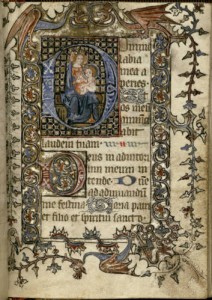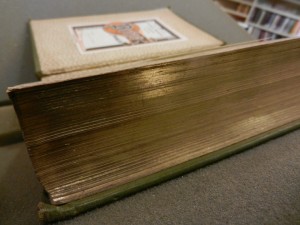
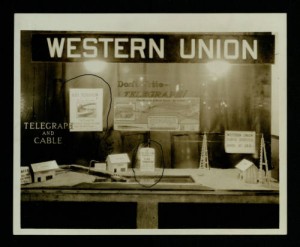
Naming campaign, Western Union storefront (1927) / from the USS Houston (CA-30) Photographs / (sign in window reads, “if you want a new cruiser named ‘U.S.S. Houston’ telegraph your congressman or the Secretary of the Navy”)
The recent publication of the USS Houston (CA-30) Photographs, adding to the growing Military History Collections at our Digital Library, marks another major milestone and means even more research potential for remote scholars unable to visit our rich USS Houston physical archives and materials.
Pulled from the photographs of the Cruiser Houston Collection, this new digital collection highlights the history of the heavy cruiser and her crew–the survivors, prisoners of war, and those who gave all. The flagship of the Asiatic Fleet during World War II, the Houston fought in the Battle of the Java Sea and to her bitter end at the Battle of Sunda Strait, sinking just after midnight as February turned into March, 1942. Highlights in the collection date back to the naming campaign that gave her our city’s name, include documentation of President Franklin D. Roosevelt’s affinity for the Houston as his vessel of choice for sea voyages and deep sea diversions during his presidency, show haunting scenes from those infamous POW camps, and testify to the resolve of 1,000 “Houston Volunteers” who answered the call sent out by the sinking of the Houston.
![Evacuation of POWs, Rat Buri, Thailand ([1945])](http://weblogs.lib.uh.edu/speccol/files/2014/09/evacuation_of_pows_rat_buri_thailand_1945-300x215.jpg)
Evacuation of POWs, Rat Buri, Thailand [1945] / from the USS Houston (CA-30) Photographs
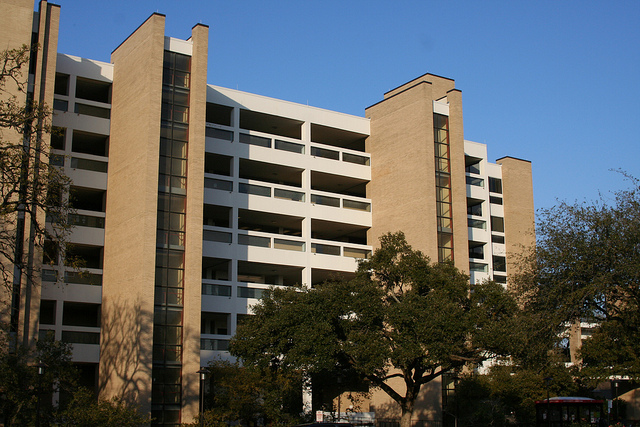
Kenneth E. Bentsen, Agnes Arnold Hall (1968), south elevation (Photo Eric E. Johnson, by permission)
In a recent post I analyzed the formal aspects of Agnes Arnold Hall. Like other buildings, it is a product of its time. Looking closely, we can see that Kenneth Bentsen interpreted some new ideas about composition and building layout that emerged in the early 1960s.
Agnes Arnold Hall owes more than a little to a well-known building at the University of Pennsylvania, the Richards Medical Research Building (1961) by Louis Kahn. The Richards was one of the most influential designs of the 1960s. Why? Prior to this, modern architects often expressed the building as a perfect geometric shape—usually a box and often a glass box. The usual practice was to place support services such as restrooms and stairwells in the center with the human occupants on the outside near the windows.

Louis I. Kahn, Richards Medical Research Building, University of Pennsylvania (Photo Richard Anderson by permission)
Kahn’s big breakthrough was to pull the support services out of the central core and place them on the outer edge of the building. There the services, housed in tall brick towers, became an important part of the building’s overall design (no more box!). Likewise, in Bentsen’s building the corridors, stairwells, and elevators are on the outside where they contribute to the design.
Agnes Arnold Hall also shows the influence of Paul Rudolph, another important architect of the period. He helped popularize the style known as “Brutalism,” with its monumental concrete buildings. Best-known was his Yale University Art & Architecture Building (1963).
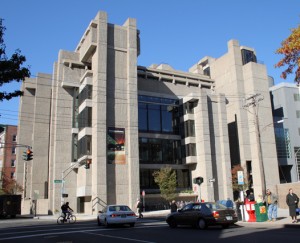
Paul Rudolph, Yale Art & Architecture Building (Photo Sage Ross, CC BY-SA 2.5)
Rudolph’s buildings were extremely complex. Occupants negotiated frequent level changes, as every floor seemed to be a mezzanine to another floor. The Yale A&A was said to have 37 different levels on 9 floors. And like Kahn’s building, some of the towers on the outside held stairs, elevators, and restrooms.
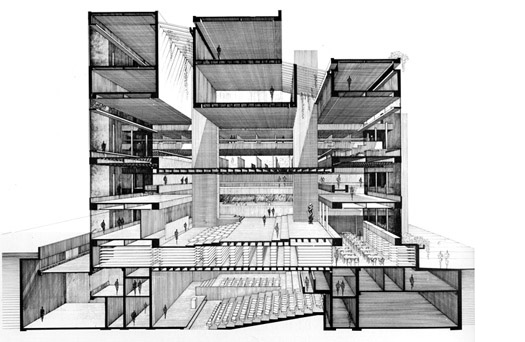
Yale Art & Architecture Building, section view (The Paul Rudolph Archive, Library of Congress)
In a small way you see some of this spatial complexity at Agnes Arnold Hall. Escalators (now stairs) thread their way through a four-story lobby area that is open to the outside. The lobby flows into an open courtyard at the basement level, and visitors enter the building over a bridge that spans this courtyard. But Rudolph’s influence is also apparent in the way the concrete is finished. Most of Bentsen’s building is faced in brick, but at the basement level the concrete retaining walls of the courtyard have what is called a “corduroy” finish. This was Rudolph’s trademark (look closely at the Yale building). After the concrete walls were poured and the forms removed, the workers attacked the surface with a jackhammer. Instant texture.
The Kenneth E Bentsen Architectural Papers, housed at the University of Houston Special Collections, are currently being processed.
Whether it’s a rare book printing found at long last or piece of ephemera found in an archival collection by chance, those who visit the University of Houston Special Collections almost always find something they cannot wait to share with others. Here we celebrate what makes the University of Houston Special Collections so special–our Favorite Things.
This series is intended to shine a light on some of the most prized things we find here in Special Collections. Sometimes, however, we are reminded that the most special of all aren’t the objects that reside in our stacks, but the people who walk through our doors.
Not long ago I was witness to a special treat in the reading room. Headed out to our foyer desk to greet a patron, I was somewhat surprised when I encountered an elementary school-aged child. While a family member searched the general stacks, this young girl had intrepidly set out in search of older, rarer quarry.
I thought of all the amazing rare books in our collections, and tried to come up with the perfect example to share. Just before we went into the reading room to begin viewing materials, we were joined by Pat Bozeman, Head of Special Collections. Her mind quickly went to the Book of Hours, Use of Reims as a treat worthy of such a delightful and curious patron.
Watching the young researcher excitedly encounter this book was one of my favorite moments since joining the UH Libraries. It was a pleasure to watch and listen as Pat explained how the book was made and pointed out interesting details to a completely captivated child. And the girl’s reactions were a reminder of the wonder that these fantastic holdings have the power to elicit. There are lots of great things about working in the reading room, but there isn’t much that can top a child’s sincere “wow!”
The experience not only underscored the responsibility we here in Special Collections have for preserving and making accessible our cultural heritage, but was also a reminder of just how darn lucky we are to get to do it.
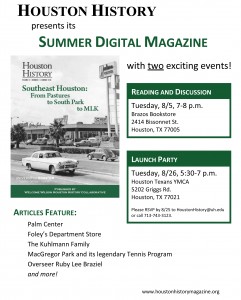
The summer 2014 digital issue of Houston History features a piece on the history of Foley’s in the city of Houston
The second digital issue of Houston History (Summer 2014) is on the virtual shelves and features a piece by our own Dr. Tomkins-Walsh, “From the Archives: Remembering Foley’s,” featuring research and images from the Foley’s Department Store Records.
We have written previously, lamenting the demise of a Foley’s presence, influencing and shaping Houston’s downtown, prior to the ultimate demolition of Kenneth Franzheim‘s bold design. For her part, Dr. Tomkins-Walsh addresses the demolition of that building in September of 2013 as something of a catalyst on the collective, public memory that wants not for a building, but instead represents more of a nostalgia and longing for an old figurative pillar and community partner long gone. From its origins as a dry goods store, to an early department store, through the post-war optimism reflected in the construction of Kenneth Franzheim’s icon, to the role it played in the desegregation of Houston, and on into the growth of branch stores that followed the patterns of suburban development, Tomkins-Walsh outlines in detail the symbiotic relationship that Foley’s enjoyed with the community, as well as the rich research potential the meticulous records hold across a number of fields of study.
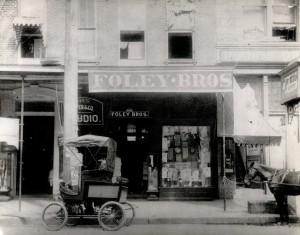
Foley Bros. on Main St. (1906) – available for high resolution download at our digital library
Subscribers of Houston History may read Dr. Tomkins-Walsh’s article and the rest of the latest digital issue online at the magazine’s website. In addition, a launch party for the summer digital issue is scheduled for Tuesday, August 26th from 5:30pm to 7:00pm at the Houston Texas YMCA (5202 Griggs Rd., Houston, TX 77021). Interested in learning more about the history of Houston as seen through that huge display window on Main Street? Plan a visit to the Special Collections Reading Room and take a closer look at the Foley’s Department Store Records.
In addition to the over 7,000 linear feet of archival collections made available for study at the University of Houston Special Collections, we are also proud to offer over 100,000 rare and antique books for use in our reading room. Each month we will highlight a text from our collections and what makes it so special.
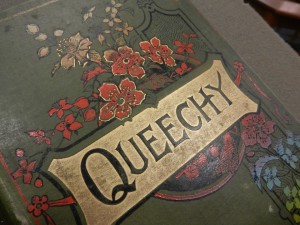
cover of Queechy / by Elizabeth Wetherell (Susan Warner)
Book of the Month: Queechy by Elizabeth Wetherell, as recommended by Julie Grob, Coordinator for Instruction at the University of Houston Special Collections.
Why So Special? “The pictorial cloth binding with a decoration of flowers that are multicolored,” writes Grob. “I’m a sucker for over-the-top publishers bindings from the 19th century, and this is one of the more elaborate in our collection.”
Originally published in 1852, Queechy was Susan Warner’s second novel, following her widely-translated debut, The Wide, Wide World (1850), also written under the pen name Elizabeth Wetherell. That book’s popularity gave Warner the distinction of being one of the most popular authors of a new nation still finding its literary voice. Our copy of Queechy is a glittering and gilded display that no doubt would have brought color to the cheeks of Warner’s Puritan forebearers. “Pictorial green cloth stamped in gold, red, blue, yellow and black. Edges gilt.”
Location: Pictures will not do this one justice. If you would care for a closer look, Queechy is available for study in the University of Houston Special Collections Reading Room, during our normal research hours. To spend some time with Fleda Ringgan as she crisscrosses the Atlantic, please request PS3155.Q4 1800z.
